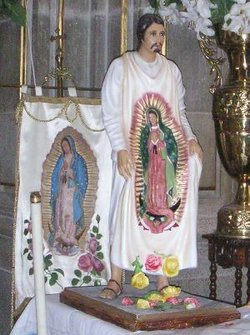Juan Diego Cuauhtlatoatzin
|
|
Tradition maintains that Juan Diego Cuauhtlatoatzin was an indigenous Mexican who had a vision of the Virgin Mary as Our Lady of Guadalupe. He was canonised in the Catholic Church on July 31, 2002, becoming the first Native American Roman Catholic saint.
Juan Diego, according to the story generally accepted by Catholics, was born in 1474 to a peasant family in the Chichimeca nation. His birth name, "Cuauhtlatoatzin", is in the Nahuatl language and has been translated as "He who talks like an eagle". He was born and grew up in Cuautitlán, a city in the Aztec Empire, about 20 km north of the Aztec capital Tenochtitlán (now Mexico City).
The date of Cuauhtlataotzin's conversion to Catholicism is variously given as 1524 or 1525. He took the name "Juan Diego" and moved to Tolpetlac, closer to Tenochitlan and the Catholic mission that had been set up by the Franciscan friars. During a walk from his village to the city on December 12, 1531, he saw a vision of the Virgin Mary at the Hill of Tepeyac, who spoke to him in Nahuatl. She told him to build a church on the site, but when Juan Diego spoke to the Spanish bishop, the bishop did not believe him, asking for a miraculous sign. The Virgin told him to gather flowers from the hill, even though it was winter, when normally nothing bloomed. He found Spanish roses and presented these to the bishop. When the roses fell from his apron, an icon of the Virgin remained imprinted on the cloth.
The church was built in 1533, and thereafter Spanish missionaries used the story of Juan Diego's vision to help convert millions of indigenous people in what had been the Aztec Empire. Our Lady of Guadalupe, as the Virgin Mary came to be known in this context, still underpins the faith of many Catholics in Mexico and the rest of Latin America, and she is now recognised as patron saint of America. But Juan Diego himself, who died on May 30, 1548, has also been revered by many people.
In 1990, Pope John Paul II beatified him and, shortly thereafter, miracles began to be attributed to him, starting with a healing on May 6. This sparked further investigation by Catholic authorities, and on July 31, 2002, the Pope declared Juan Diego a saint.
Sceptics, however, including some Catholics, have doubted the very existence of Juan Diego. The earliest written reference to him dates from 1648, in a publication by a Mexico City priest about Our Lady of Guadalupe. A 1649 publication in Nahuatl followed, referring to earlier Nahuatl sources that have not been found. In 1666, a formal Church inquiry gave authority to the traditions of Juan Diego. Sceptics believe that these sources, over a century after the events were supposed to have occurred, were actually part of an attempt by Catholic missionaries to bolster the legend of Our Lady of Guadalupe, which they were using to win the hearts of indigenous potential converts. In 1996, Guillermo Schulenburg, then abbot of the present Basilica of Guadalupe, wrote in a Jesuit publication that he considered Juan Diego symbolic, not historical, and that the image on the apron (now displayed in the church) was a painting. Schulenburg and some other Catholic clerics wrote a letter to the Vatican asking for a delay in the canonisation process, but they charge that the official investigators ignored the evidence that they presented.
Believers have responded that the doubts are a symptom of racism against indigenous peoples. Whether or not this charge is valid, it is true that many of Mexicans see the canonisation of Juan Diego as a symbolic victory in the movement for greater recognition of indigenous rights in Mexico. At the canonisation ceremony at the Basilica, the Pope held a Mass that borrowed from Aztec traditions, including a reading from the Bible in Nahuatl. The Pope urged the Catholic Church in Mexico to be respectful of indigenous traditions and to incorporate them into religious ceremony when appropriate. Significant segments of Mexico's indigenous population is converting to Protestantism, and many feel that Catholic Eurocentrism may be turning them off. Indeed, many native groups objected to the Church's official depiction of the saint, charging that he was made to appear far too light-skinned, incongruously bearded, and altogether more European than Aztec. At the same time, the Pope urged fighters for indigenous rights to renounce violence; the Zapatista movement, which often uses images of Our Lady of Guadalupe in their propaganda, had recently done just that.
See also
External links
- Biography from a Catholic site dedicated to Our Lady of Guadalupe (http://www.sancta.org/juandiego.html)fr:Juan Diego Cuauhtlatoatzin

